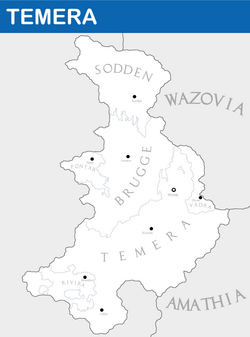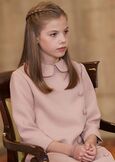Temera: Difference between revisions
mNo edit summary |
m (→Demographics) |
||
| Line 217: | Line 217: | ||
==Demographics== | ==Demographics== | ||
==Urbanisation== | |||
{{Largest cities of Temera}} | |||
===Ethnic groups=== | ===Ethnic groups=== | ||
Revision as of 19:34, 12 July 2019
Crown of Temera | |
|---|---|
 | |
| Capital and largest city | Rivne |
| Official languages | Temeran Wazovian |
| Recognised national languages | Gaullican |
| Recognised regional languages | Amathian Soddoon |
| Ethnic groups (2018) |
|
| Religion (2018) |
|
| Demonym(s) | Temeran |
| Government | Unitary parliamentary constitutional monarchy |
• Queen | Głurzana I |
| Filip, Duke of Tarnov | |
| Marzyn Izłarzany | |
| Legislature | Koroć Żeniarały |
| Kębra Nubły | |
| Kębra Komyni | |
| Population | |
• 2018 census | 16,203,405 |
| GDP (PPP) | estimate |
• Total | $509.726 billion |
• Per capita | $31,458 |
| GDP (nominal) | estimate |
• Total | $266.675 billion |
• Per capita | $16,458 |
| Gini (2017) | 36.4 medium |
| HDI (2017) | 0.871 very high |
| Currency | Temeran Pieniądze(Ᵽ) (TPD) |
| Driving side | left |
Temera (Temeran: Ciamraje), officially the Crown of Temera (Temeran: Koruna Ciamraja), is a country located in Western Euclea. The country is bordered to the south and east by Amathia, and to the east by Wazovia. Temera's x square kilometres (y sq mi) were home to an estimated 16.2 million inhabitants in 2018.
Temera is a unitary parliamentary democracy and constitutional monarchy. The current monarch is Queen Głurzana I, who has reigned since 2014. Temera's capital and largest city is Rivne, a cultural hub and financial centre with an urban area population of 1.8 million. Other major cities include Leonior, Kolonia, Leblic, Montebov and Thorn
The Crown of Temera consists of five constituent nations: Temera, Brugge, Sodden, Pontar, Rivira, and Vadra. Their capitals are Rivne, Leonior, Kordyn, Paryz, Montebov, and Thorn, respectively. The nations have their own devolved governments, each with varying powers, but such power is delegated by the Courts General of Temera, which may enact laws unilaterally altering or abolishing devolution.
During the Iron Age, what is now Temera was inhabited by the Mereics, a Tenic people. Solaria conquered part of the area in x BS, while assigning other parts to client kings. The Solarian rump state of Arciluco held it until the arrival of Marolevs in x AD, who formed several polities.
Etymology
Temerae -> 1. Tǐměrjě -> 2. T'ьm'rějě -> 3. Ciamrějě -> 4. Ciamraje
prōvincia -> 1. prŭvěncja -> 2. prъvěnʲdjě -> 3. prevʲěńdzě -> 4. provjandze
īnfantem -> 1. infantjě -> 2. jinfont'ě -> 3. jinfontě -> Infonta
History
Prehistory and protohistory
-Mostly Celtic
Antiquity
-Solarian Empire -Slavic migrations
Early Middle Ages
Late Middle Ages
Early Modern period
Modern period
Contemporary period
Geography
Politics
Temera is a unitary state under a constitutional monarchy. Queen Głurzana I is the monarch and head of state of Temera. The constitution grants the monarch executive and honorific powers. They preside over the Privy Council; appoints the Prime Minister, usually from the political party that has won the most seats in the parliamentary elections, and on recommendations from the latter, appoints the members of the government. The monarch also has the power to terminate the tenure of any minister, and to unilaterally dissolve the Parliament, suspend the constitution, call for new elections, or rule by decree. The only time this happened was in 19xx. The monarch is formally the commander-in-chief of the armed forces.
Government
Temera has a parliamentary government based on the Ashcombe model. The parliament of the United Kingdom meets in the Palace of Setidava and has two houses: an elected Commons Chamber and a hereditary Noble Chamber. All bills passed must be given Royal Assent before becoming law.
The position of prime minister (Temeran: Don Prezydent Kuzielu, Lord President of the Council), Temera's head of government, belongs to the person most likely to command the confidence of the Commons Chamber; this individual is typically the leader of the political party or coalition of parties that holds the largest number of seats in that chamber. The prime minister chooses a cabinet and its members are formally appointed by the monarch to form Her Majesty's Government. By convention, the monarch respects the prime minister's decisions of government.
The cabinet is traditionally drawn from members of the prime minister's party or coalition and mostly from the Commons Chamber but always from both legislative houses, the cabinet being responsible to both. Executive power is exercised by the prime minister and cabinet, all of whom are sworn into the Privy Council of Temera, and become Ministers of the Crown. The current Prime Minister is Marzyn Izłarzany, leader of the Catholic People's Party who has been in office since 12 June 2007. Temera is divided into 525 constituencies, used to elect members of the Commons Chamber. General elections are called by the monarch when the prime minister so advises, and by convention should be called within five years of the last.
Devolved administrations
Temera, Brugge, Sodden, Pontar,, Rivira, and Vadra each have their own government and executive, led by a Chief Minister and a devolved bicameral legislature.
Administrative divisions
Foreign relations
Military
Economy
Demographics
Urbanisation
| Rank | Rzalmię | Pop. | Rank | Rzalmię | Pop. | ||||
|---|---|---|---|---|---|---|---|---|---|
 Rivne  Leoniór |
1 | Rivne | Temera | 1,458,476 | 11 | Rumuń | Sodden | 294,510 |  Kołonia  Lębłyk |
| 2 | Leoniór | Brugge | 771,069 | 12 | Frącja | Vadra | 246,309 | ||
| 3 | Kołonia | Temera | 685,285 | 13 | Jałta | Pontar | 222,292 | ||
| 4 | Lębłyk | Temera | 640,648 | 14 | Ślen | Brugge | 213,029 | ||
| 5 | Męć Bowiny | Rivira | 536,438 | 15 | Warzyn | Rivira | 202,074 | ||
| 6 | Turoń | Vadra | 466,631 | 16 | Dzień | Sodden | 202,036 | ||
| 7 | Kordyn | Sodden | 402,465 | 17 | Sątakrucz | Temera | 195,774 | ||
| 8 | Paryz | Pontar | 350,178 | 18 | Leonina | Temera | 191,564 | ||
| 9 | Łotwa | Brugge | 339,682 | 19 | Kaliża | Sodden | 179,806 | ||
| 10 | Rygień | Temera | 297,459 | 20 | Oszkól | Vadra | 173,374 | ||
Ethnic groups
The Act of Nationalities, 1967, recognises several contemporary nationalities, within the context of the Temeran Crown. Distinct traditional identities within Temera include the Temerans, Bruggans, Soddoons, Pontarans, Rivirans and Vadrans. These identities tend to transcend ethno-linguistic lines, with Temerans, Soddoons, Wazovians and Amathians sharing common historical identities.




